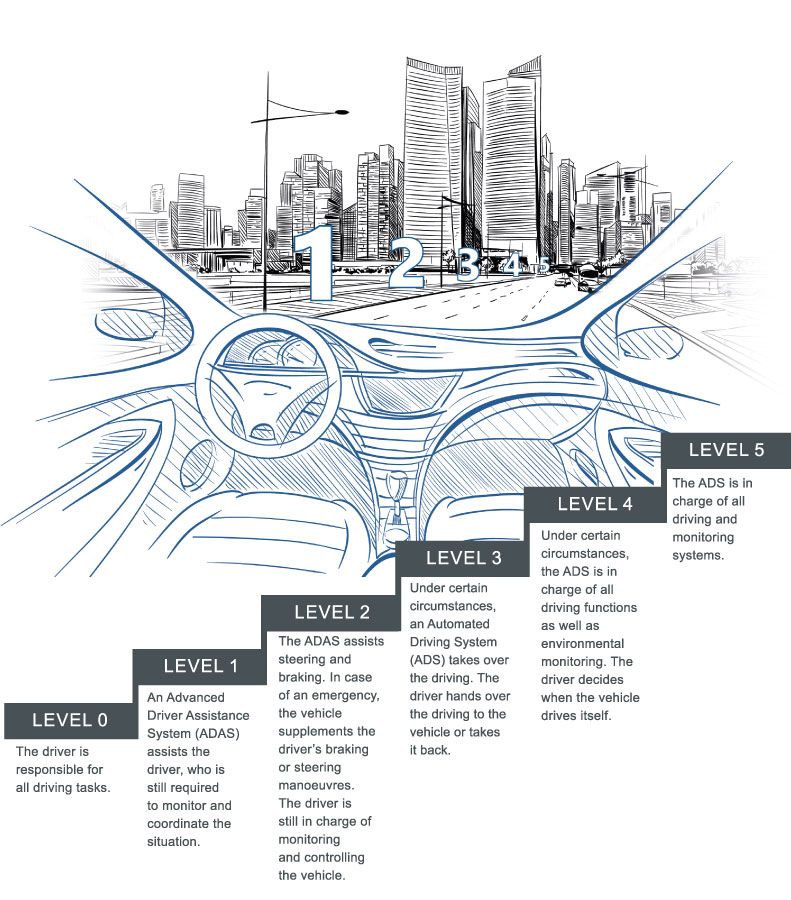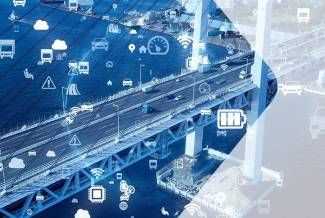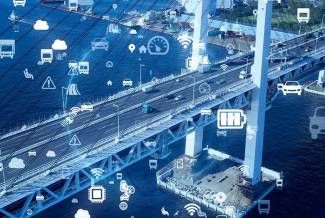Connected Mobility:
Transport & Logistics of the Future
Connected mobility is an important component of future mobility. Intelligent networking, constant data exchange and comprehensive digitalisation of all road traffic will benefit transport and logistics on many levels. First and foremost, data-based solutions ensure greater efficiency and environmental protection. Because connected mobility systems can avoid traffic jams, increase safety on the roads, enhance travel comfort and, last but not least, reduce pollutant emissions.
Definition: Connected Mobility
Connected mobility describes the technological possibility for different modes of transport – e.g. cars, buses, trains, trucks, ships – to communicate seamlessly with each other and exchange traffic data in real time.
Good to know: When all road users in the mobility network communicate with each other, a smooth flow of traffic and transport without delays becomes possible.
What will connected mobility change?
What is getting better?
Connected mobility concepts will assert themselves where a lot of traffic flows, i.e. primarily in cities and metropolitan regions. Since most cities and metropolitan areas worldwide face almost the same transport policy challenges, comprehensive networking should help to organise transport more sustainably and efficiently.
Specifically, the networking of transport users and systems should accelerate the following improvements, among others:
Reduce congestion
Reduce the number of accidents
Limit individual traffic
Reduce waiting times at traffic lights
Enable green waves
Reduce CO₂ & particulate matter
Avoid stop-and-go traffic
Make it easier to find a parking space
Make public transport more attractive
Speed up logistical journeys
Reduce noise & sound levels
Enable more green zones
Good to know: If all accessible means of public transport, rental bikes, e-scooters, rental cars, etc. are connected and can be accessed via an app, city dwellers can travel flexibly from A to B without having to use their private car.
How do you achieve these goals through more networking?
In order to achieve the aforementioned (and other) goals, many technologies are already being discussed that (should) enable sustainable and efficient connected mobility. The 5 most important "technologies" of a Connected Mobility are briefly presented below.
#1 Connected vehicles
Networking between vehicles – e.g. so-called car-to-car communication – is considered by many experts to be a prerequisite for the future of autonomous driving.
Connected vehicles can already have a positive influence on traffic today:
Cars or lines of cars that brake and accelerate at the same time increase the flow of traffic.
Vehicles driving ahead can warn other road users in real time - e.g. of obstacles, black ice, etc. - and thus minimise the risk of accidents.
Good to know: Currently, drivers are left to their own devices in road traffic. Vehicles that are connected and communicate with each other, on the other hand, enable coordinated driving – depending on traffic and situation. In this way, connected mobility ultimately contributes to fewer traffic jams, accidents, stop-and-go traffic, emissions and more traffic flow.
#2 Connected transport systems
In addition, networking between vehicles and traffic systems will play an important role, the so-called Car-to-X communication. Numerous advantages are obvious, such as the following:
Traffic lights that communicate with vehicles can reduce waiting times by up to 40% and increase traffic flow by up to 60%.
Automatic systems can monitor compliance with traffic rules (speeds, distances, etc.) very efficiently and thus contribute to greater safety.
Good to know: Commuters often spend much longer in the morning traffic jams on the roads leading into the city than they should. If digital, connecte traffic systems release (or close) additional lanes depending on the current load, traffic can flow more smoothly and adapt flexibly to the respective peak times.
#3 Smart parking
Modern parking management is an important component of connected mobility in cities. Currently, up to 40 percent of traffic in cities is accounted for by the search for a parking space alone. In this respect, mobility hubs in particular can help to make parking possible in an organised way where there is really space - i.e. outside large cities.
Fewer parked cars bring the following advantages:
More green spaces or places used by the public (e.g. cafés) are created.
There is more space for pedestrians and cyclists.
Good to know: Even at peak times, on average only 10 % to 15 % of all vehicles on the streets are used. This means that more than 80 % of all vehicles in cities stand unused, taking up valuable space that cities could use in other ways - as far as modern parking management allows.
#4 Autonomous driving
Autonomous vehicles will certainly shape the future of urban mobility, but the technology will still need time to assert itself. The advantages are obvious:
The total number of vehicles within a city would decrease enormously - according to the motto "use instead of own".
Parking of autonomous vehicles will take place outside the city, creating more green spaces, cycle paths, etc.
The most important argument is: "more safety", because over 90 % of all car accidentsare due to human error.

The path to autonomous driving – according to the prevailing expert opinion – will proceed in several steps. The most important are as follows:
Step: assisted driving (e.g. parking or lane assist).
Step: partially automated driving (hand remains on the handlebar)
Step: highly automated driving (hands-free driving possible to a limited extent)
Step: autonomous driving (vehicle drives independently)
Good to know: Another basic prerequisite for self-driving cars or automated driving is a reliable infrastructure. Modern road markings – utilising road marking systems – play a key role here. Or in the words of Elon Musk: "We really need better road markings."
#5 Mobility as a service & micromobility
There are many good reasons why Mobility as a Service (Maas) will prevail in the future - especially in large cities and metropolitan regions. In order to enable flexible and convenient travel – without having to use the car – such service offers are always oriented towards customer needs, integrating many ways to get around, such as:
Public transport (bus, train, underground, tram, cable cars, etc.)
(e-)bike sharing
Air taxis, drones, helicopters etc. (future scenario)
Taxis, ride-hailing, ridepooling, car-sharing or shuttle services
E-scooter sharing
Ships and ferries (if rivers and lakes in the city)
Good to know: The primary goal of MaaS is to provide mobility services tailored to the individual needs of city dwellers. This also applies to micro-mobility vehicles (e-scooters), because a pleasant travel option for the last metre (to the front door) is often the winning argument for (permanently or partially) doing without a car.
Connected Mobility: Additional Topics
read more: CCAM: Cooperative, Connected & Automated Mobility
Conclusion: Connected Mobility
Connected mobility offers solutions for a trend we are observing worldwide - namely that the majority of people today live in large cities - and the trend is rising. According to official United Nations forecasts, up to 70 percent of all people could live in cities as early as 2050.
However, current mobility in cities is largely based on individual transport and fossil fuels, with (still too) few exceptions. Both together are neither efficient nor ecologically sensible.
But just as generational thinking is changing (keyword: Fridays for Future), technologies are evolving and acceptance for innovative (shared) solutions is increasing - both of which are a basic prerequisite for connected mobility concepts to take hold.
Last but not least: The mobility of the future will be connected: Finding the right vehicle at the right place for the respective individual need will be possible with the help of comprehensive networking of all transport participants & systems and will offer real sustainable alternatives to individual transport.
Contact Us
SWARCO has proven to be a reliable partner for governments around the world, resulting in a rapidly growing number of successful projects in different regions. Do you have a question regarding connected mobility? Send us a message, and our C-ITS experts will be happy to assist you.
FAQs – Frequently asked questions
Connected mobility is a collective term for the development of digital technologies to promote the networking of vehicles – with each other (Car2Car) and with their environment (Car2x).
Good to know: Both together are also called CCAM (cooperative, connected and automated mobility).
Connected mobility is a central component of the mobility transition: If city dwellers can use different - ideally shared - means of transport easily and cheaply to get from A to B, they will move around more efficiently, save space and be more sustainable.
The networking of transport vehicles with each other, with their clients and with their environment speeds up the location of freight, reduces empty runs and detours, optimises fuel consumption and ensures overall improved utilisation of the entire fleet.
In the future, the networking of vehicles, new transport options and more automation will contribute to urban dwellers increasingly foregoing their cars and resorting to alternative – shared – means of transport.
The majority of future transformation processes will take place in cities and metropolises. The entirety of these technologies, concepts and processes driving change is summarised under the buzzword urban mobility.
The mobility of the future lies in digitalisation: Big Data, 5G, artificial intelligence and more connectivity increase safety, improve efficiency and reduce environmental pollution. The resulting mobility concepts are setting profound changes in motion.

